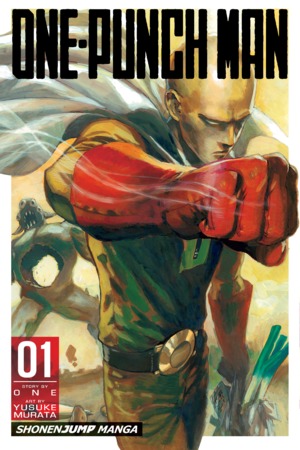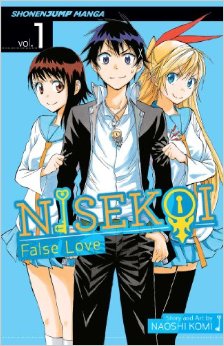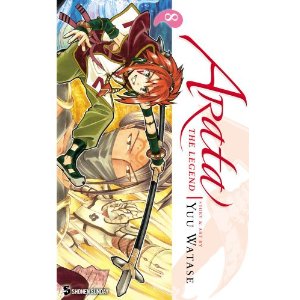I absolutely adored the first few volumes of Kekkaishi. It is rare for me to find a shonen series that I like that features art that is both clear and visually arresting combined with plenty of character development, adventure, and the occasional bit of humor. But even though I liked what I’d read when I started reading the series back in 2010, the length of the series at 35 volumes made me a bit hesitant to commit to collecting it. I’ve had volumes 20-25 stockpiled for future reading for some time now, but the Viz digital sale during the holidays and my rapidly diminishing bookshelf space prompted me to pick up 10-19 for my iPad.
These volumes feature Yoshimori in the middle phases of his shonen hero journey. He’s a little bit more self-assured and more confident and slightly less goofy around girl next door and fellow Kekkaishi Tokine. There are glimmerings of great power that make the suggestion that he’s “the chosen one” seem plausible, but he hasn’t yet fully grown into his abilities. Tanabe does a good job fitting in more episodic adventures into the larger mystery that Yoshimori is pursuing as he tries to find out the truth behind the mystical Karasumori site he is sworn to protect.
Volumes 10 and 11 deal with a powerful attack and the aftermath when powerful opponents visit the Karasumori site. Gen, Yoshimori’s new ally who is uneasy in his skin due to his half akashi nature, but he tries to help out Yoshimori as best he can. A fox princess and her retainers are visiting the site so she can gain power, which gives Tanabe the chance to create some lovely scenes where a pavilion is transported via gianty dragonfly ships, piloted by a spider-like woman, and accompanied by ninjas who drop out of the black clouds filling the sky.
Yoshimori’s brother is away on Night Troops business, casually flying through the air on a translucent Kekkai cube, talking strategy to Gen on his cell phone. Yoshimori, Tokine, and Gen band together to defend their site, with more strategy and skill than their opponents expect. Gen finds more acceptance than he anticipates from Yoshimori when he reveals his true powers, but he’s surprised by a sneak attack. The Fox Princess, expecting to find rejuvenating power, starts getting sick instead from the site. One of the reasons why I enjoy Kekkaishi so much is that it is able to portray a variety of emotional states in just a few pages, without ever feeling rushed. Yoshimori grieves the loss of his friend, then decides that he’s determined to exact revenge and become stronger. There’s a funny sequence where he tries to join forces with Tokine’s grandmother, and since she’s trying her best to dodge him, he brings a secret weapon – not a new mystical power but a skateboard. Tanabe’s akashi designs are always interesting – one of the foes the Night troops fight when they attack Kokuboro is a giant blobby monster baby.
Yoshimori’s unique powers cause him to be kidnapped and taken hostage by the Kokuboro, something that he doesn’t seem to mind all that much because he wants to destroy the akashi who took out Gen. Volumes 12 and 13 center on the battle with Kokuboro, as Yoshimori travels through his enemy’s castle in search of Kaguro. Yoshimori runs into Sen and an old friend of his grandfather’s along the way. Kaguro likes to toy with his opponents and play mind games with them. While he taunts Yoshimori, the young hero manifests a new power of destruction – a zekkai. The Night Troops come to the rescue just as the world of Kokuboro begins to crumble, and Masamori has to help deal with the aftermath of the odd power his younger brother suddenly manifested. In Kekkaishi each battle prompts moments of emotional revelation, and a big one occurs when Tokine confronts Yoshimori about his actions when he finally returns home. There are then a few stolen moments of normalcy, as Tokine goes back to her usual lectures while the friends walk to school, and Yoshimori escapes into the kitchen once again for his dessert experiments.
In volumes 14 a new ally named Takeshi appears, on the hunt for an evil spirit named Jaren who destroyed his master. Takeshi’s enthusiasm and explosive personality almost make him a parody of a shonen hero, but things quickly turn serious when the new friends confront Jaren, whose proclivities towards psychological manipulation make battle difficult. Things can’t be all doom and gloom and angsty battles, so when Yoshimori is visited by a crow goblin seeking help because his master has grown overly flirtatious, Yoshimori finds himself drawn into an odd adventure. Things take a turn for the surreal when odd black boxes start popping up that serve as portals to the home of a very disturbed man. A young, timid member of the night troops is trapped, but she ends up being remarkably resourceful with her very specific powers.
Revisiting this series reminded me of just how enjoyable shonen manga can be when it is really well done. The pacing in Kekkaishi is excellent, as Tanabe swings back and forth between epic battles and shorter episodic encounters. The fights in Kekkaishi are rarely just for the sake of fighting, as each confrontation generally leads Yoshimori into a little bit more knowledge about either the nature of the site he is protecting or how best to manage his own powers. There are plenty of manga that sacrifice clarity for looking cool – producing action scenes that are difficult to follow or overly detailed panels that end up distracting from the story. Kekkaishi’s art is easy to follow, but many of the character designs and scenes remain in my mind after I’ve finished reading a volume. I’m a little annoyed at myself for waiting so long to continue reading this series, but I’m glad that have so many volumes waiting on my to read stack now.




